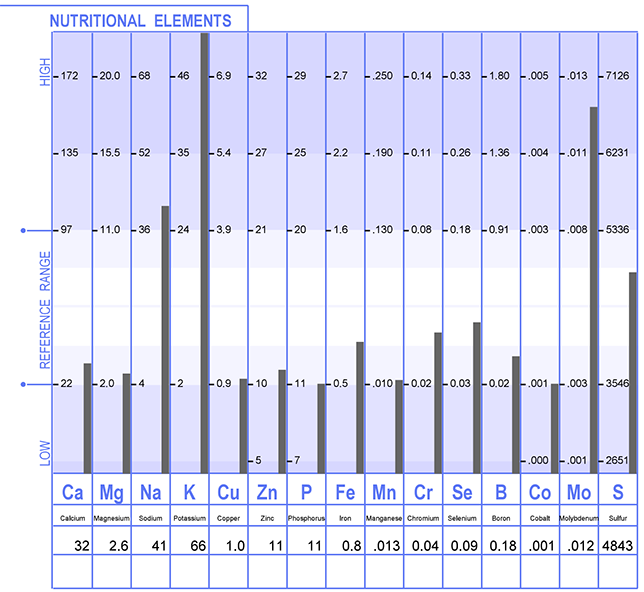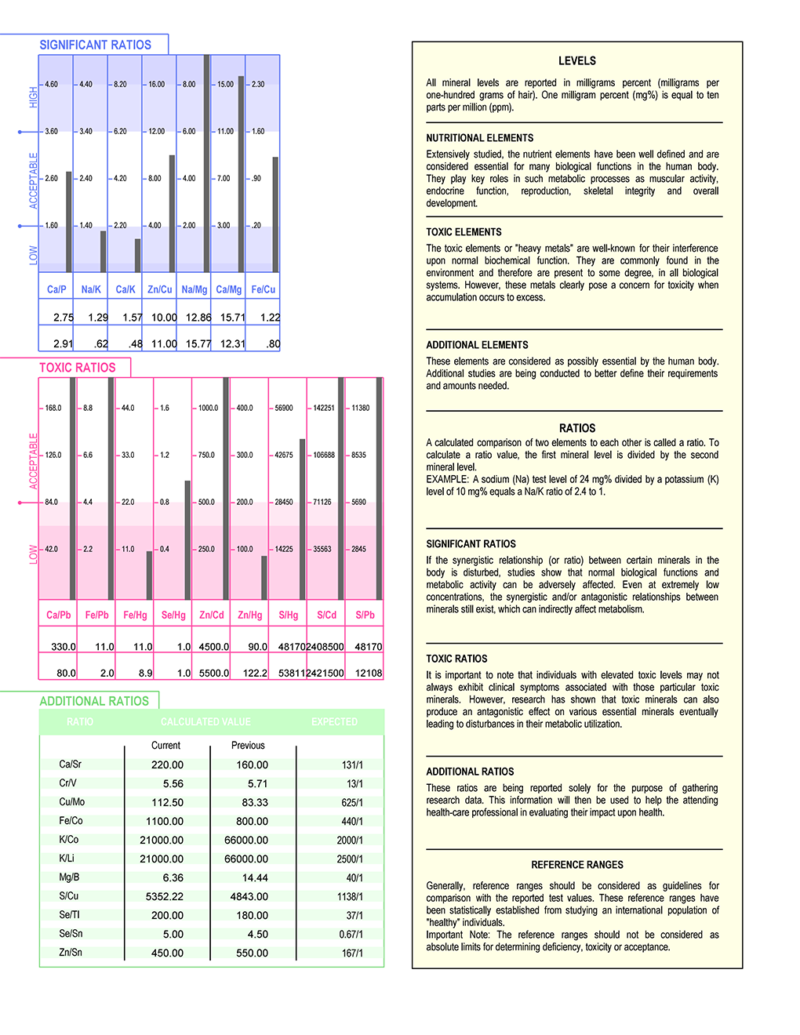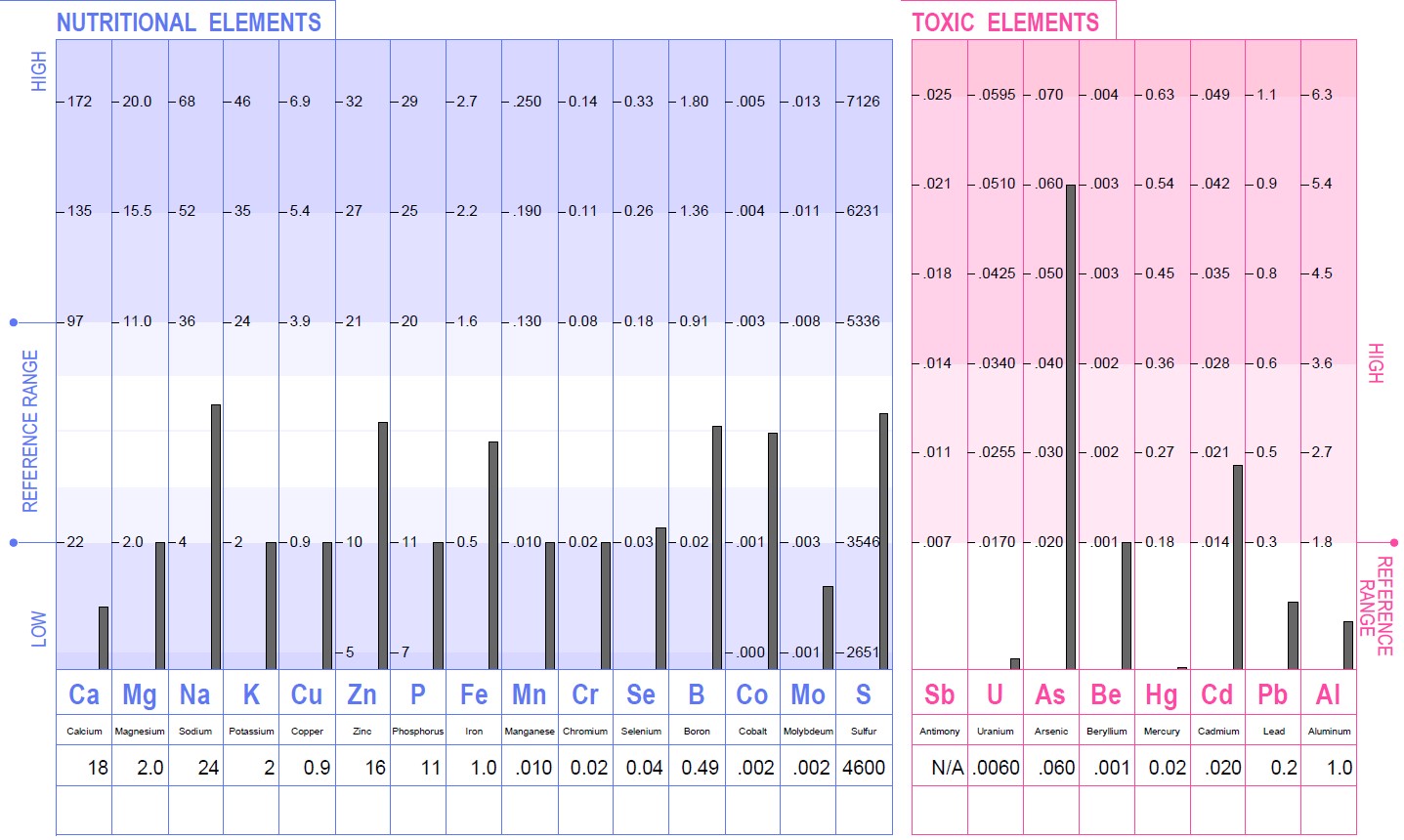General Guidelines:
- Your BioCorrect Nutrition™ Analysis (BNA) HTMA report is an analysis of 36 minerals measured in your hair.
- This clinical lab test is known as a hair tissue mineral analysis (HTMA), and is used as a basic chemistry and toxicology screening assay.
- You may hear the test referred to as your hair test, BNA or BioCorrect Nutrition™ Analysis.
- Our clinical lab partner has performed more that 123 million HTMA tests since 1984 and is widely accepted around the world.
- Your report can vary in length and information depending upon what is found.
- This report is designed for research and education purposes only.
- Please take the time to understand the information in this report – it may save your life!
- BioCorrect Nutrition™ Analysis reports consist of six sections, plus a disease tendency graphic.
- You will find a list of questions at the end of this article to prepare your for your consult with our BioCorrect Nutrition experts.
PART I:
MINERAL MEASUREMENTS and HTMA EXPLANATION
Graphs on the first two pages are tissue mineral measurements of:
- Mineral excesses, deficiencies, significant ratio imbalances and toxicities in your body at this time.
The goal is to be within the whitest areas or Reference Range on all graphs, and with correct key mineral-to-mineral ratios.
- Introduction to HTMA and understanding what the graphics mean for you.
Your goal is to understand the concepts of mineral deficiency and/or excess. Most importantly, when toxic element infiltration is clinically significant and what mineral ratios mean to your good health.
PART II:
METABOLIC TYPE and HTMA NUTRIENT MINERAL LEVELS

This part contains:
- Rate of Metabolism – slow 1,2,3,4, or fast 1,2,3,4
The goal is to understand how effectively your body utilizes nutrients in terms of glands, diet, digestion, infections and other significant symptoms.
- Nutrient Mineral Levels – discussion of nutritional mineral levels which reveal significant deviations from normal.
This section describes the possible sources and effects of key mineral excesses and deficiencies that are present in your report. Here you will understand which of the nutrient levels demonstrated are adversely affecting you the most.
Example: Slow(#4) Metabolic Type

It is important to note that having an intracellular excess or deficiency of a mineral may not mean that you have too much of the mineral in your diet. It simply means that the minerals are not necessarily being properly utilized.
For instance, “high tissue calcium does not necessarily indicate excessive calcium, but rather the calcium is not being properly utilized. Proper utilization is often dependent upon calcium’s relationship with other essential minerals, such as phosphorus and magnesium. A deficiency of either or both can result in excessive calcium deposition into tissues other than the primary storage sites of calcium (bones and teeth). Deposition of calcium into the soft tissues, includes not only the hair, but also the skin, joints, arteries, lymph nodes, gallbladder, etc.” Trace Elements Inc.
Excess tissue cobalt tends to indicate insufficient stomach acid leading to poor protein digestion, vitamin B12 absorption and utilization. Insufficient stomach acid also increases the likelihood of opportunistic microorganisms in your stomach and intestinal tract.
For those of you with dogs with a Canine BNA report, severe cobalt deficiency often suggests intestinal parasites.
PART III:
NUTRIENT & TOXIC RATIOS and TOXIC METAL LEVELS
This part contains:
- Explanation of how metabolic dysfunction occurs due to abnormal balances of minerals and related vitamins
- Symptoms of mineral imbalances
- Common sources of toxic metals
While absolute tissue mineral levels are an important part of the mineral profile, the ratios between minerals are also key to understanding how and why your biochemistry is functioning or not functioning properly.
For instance, weight loss or more correctly fat loss is one of the more common goals for many clients. The simple truth is that weight gain or the inability to burn off excess fat is often related to calcium, magnesium and sodium levels and ratios.
Just as mentioned earlier, excess tissue calcium typically signals improper utilization and not necessarily excess calcium intake. There may be a need to decrease dietary intake to help push down levels, but you’re often trying to push the calcium back into your bones and teeth where it primarily belongs.
Toxic ratios can also indicate that certain toxic metals are interfering with normal enzymatic and hormonal pathways required for proper metabolism.

PART IV:
DIETARY SUGGESTIONS
This part contains:
General dietary suggestions to correct your metabolic rate and number classification
- Food Allergies – explanation about food sensitivities (not included for reports with low allergy profiles exhibited)
- Specific foods to avoid to improve metabolic balance and rate
- Specific foods to eat everyday to improve upon metabolic rate and balance.
When it comes to best and worst foods for your body, you may find that certain mineral excesses are associated with food allergies. Excess tissue copper is associated with many food allergies and the allergy symptoms often resolve themselves once tissue copper levels are normalized. We’ve seen a number of clients have allergic reactions after drinking the popular “Green Super Foods” smoothies due to ingredients with high copper content.
Using our Fat Burning Express program as an example, we specially identified a vegetable/fruit powder that didn’t include high copper ingredients.
Example: Dietary Recommendations

PART V:
CONCLUSION
This part contains:
- Objectives of the program and further explanations about excessive nutrient and toxic minerals.
PART VI:
SUPPLEMENT RECOMMENDATIONS
This part contains:
A list of completely customized and synergized laboratory formulated supplements, clinically proven to re-balance nutritional chemistries in cases similar to your own.
They help drive the metabolic re-balancing process 20-30 times faster than food alone. Importantly, they contain precise combinations of concentrated nutrient levels that are not available through normal food consumption.
TENDENCY REPORT SUPPLEMENT
This very important section of the report contains a statistical correlation of disease tendencies. This is simply an indicator of a tendency towards a symptom, illness or degenerative disease that has developed in other cases with similar mineral patterns and measurements.
STUDY QUESTIONS:
Please do your best to determine and become familiar with the answers to these questions before calling in for your prepaid class telephone consultation. It will help your overall understand of the issues! Use this entire sheet as your guide.
- Which minerals do I have in excess? Are there any vitamins associated with these excesses – which ones and why?
- Which minerals do I have deficiencies? Are there any vitamins associated with these excesses – which ones and why?
- What mineral ratios are too high? Are there any symptoms, metabolic rate effects, or gland/hormone/ nerve antagonisms associated?
- Which mineral ratios are too low? Are there any symptoms, metabolic rate effects, or gland/hormone/nerve antagonisms associated?
- What is my metabolic type?
- Which toxic minerals are most clinically significant at this time?
- What are common sources of these toxic minerals?
- What total calorie percentage of protein should I eat each day?
- What total calorie percentage of carbohydrates should I eat each day?
- What total calorie percentage of fat should I eat each day?
- Which foods should I avoid? For Best Results, list on a separate sheet of paper and put on your refrigerator as a reminder.
- Which foods should I eat more of? For Best Results, list on separate sheet of paper and put on refrigerator and on your shopping list.
- Which supplements, by name, should I take? When and in what amount?
- BREAKFAST
- LUNCH
- DINNER
- When should I take my follow-up BioCorrect Nutrition™ Analysis test (see special supplemental report) 2, 3, 4 or more months? (Mark the retest date on your calendar).
List any other questions you may have and then e-mail us at: FeelGreat @biocorrectnutrition.com
If you have not yet ordered your BioCorrect Nutrition™ Analysis or need a BNA retest, Click Here!
For Frequently Asked Questions about HTMA testing by our lab, click here.

